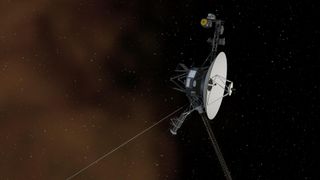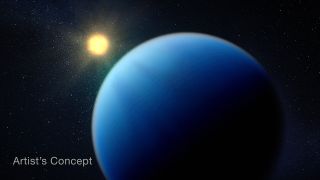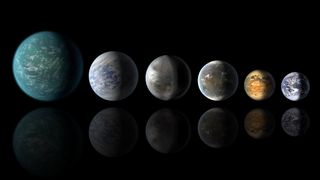
Victoria Corless
A chemist turned science writer, Victoria Corless completed her Ph.D. in organic synthesis at the University of Toronto and, ever the cliché, realized lab work was not something she wanted to do for the rest of her days. After dabbling in science writing and a brief stint as a medical writer, Victoria joined Wiley’s Advanced Science News where she works as an editor and writer. On the side, she freelances for various outlets, including Research2Reality and Chemistry World.
Latest articles by Victoria Corless

NASA continues building next-gen Roman Space Telescope despite budget worries
By Victoria Corless published
One half of the powerful new Nancy Grace Roman Space Telescope passed major milestone tests, demonstrating space readiness.

NASA resurrects Voyager 1 interstellar spacecraft's thrusters after 20 years: 'These thrusters were considered dead'
By Victoria Corless published
NASA engineers have miraculously revived the Voyager 1 interstellar probe's backup thrusters — components that hadn't been used since 2004.

Large Hadron Collider finds first evidence of important exotic heavy antimatter particle
By Victoria Corless published
Researchers at the Large Hadron Collider — the world's largest and highest-energy particle accelerator — have observed a real-life transmutation of lead into gold.

'Marsquakes' reveal clues about a hidden body of water on Mars
By Victoria Corless published
A new study offers key insights into Mars' water cycle.

James Webb Space Telescope finds water in the air of exotic 'sub-Neptune' exoplanet
By Victoria Corless published
NASA's James Webb Space Telescope has found water vapor swirling in the air of a distant, boiling-hot alien planet, a new study reports.

3D-print a realistic supernova remnant with NASA's new models of Chandra X-ray images
By Victoria Corless published
New 3D-printable models of Chandra X-ray Observatory images will allow you to hold a star in your hands and touch a supernova remnant.

Where does the universe's gold come from? Giant flares from extreme magnetic stars offer a clue
By Victoria Corless published
Scientists have finally gathered direct proof of how the universe forges its heaviest elements, a process that has remained a mystery for over half a century.

Lost in space: Why some meteorites look less 'shocked' than others
By Victoria Corless published
Scientists have long wondered why carbon-rich meteorites appear less affected by violent impacts than those lacking the stuff. They may finally have an answer.

Mars is covered in evidence of ancient lakes, rain and snow — but scientists aren't sure how that's possible
By Victoria Corless published
Valleys on Mars suggest the Red Planet was once covered in flowing water — but it's still a mystery how that could have been.

Astronomers discover doomed planet shedding a Mount Everest's worth of material every orbit, leaving behind a comet-like tail
By Victoria Corless published
Astronomers discovered a planet that orbits its star so closely that its surface is being scorched into magma and vaporizing into space.

NASA's Curiosity rover finds major clue that Mars was once habitable
By Victoria Corless published
NASA's Curiosity rover has found iron-rich carbonates on Mars — a major clue that the Red Planet used to be habitable.

NASA developing 1st-ever space-based quantum sensor for gravity measurements
By Victoria Corless published
Scientists are developing an advanced quantum sensor for low Earth orbit that can detect the tiniest tremors in Earth's gravity.

Alien life could exist on Saturn's big moon Titan — but finding it will be tough
By Victoria Corless published
Alien life could exist on the huge Saturn moon Titan, but probably not in the abundance scientists once hoped, according to a new study.

The sun just leaked a huge amount of helium-3 — the rare isotope scientists want to harvest on the moon
By Victoria Corless published
The sun was caught bursting out a huge quantity of helium-3, an isotope that's scarce in our solar system.

The epic total solar eclipse of 2024 caused some birds to stop singing
By Victoria Corless published
Scientists were watching for changes in bird vocalization patterns during the 2024 total solar eclipse. Here's what they found.

How science gets tested on alien worlds: 'We quickly realize how much there is yet to discover'
By Victoria Corless published
New insights into the chemistry of exoplanet atmospheres indicates planet-wide rainfall might take place following hydrogen atmosphere and water mixing.

Scientists are using stellar 'quakes' to peer inside stars
By Victoria Corless published
Scientists are probing stellar "quakes" to understand what lies beneath the surface of a star's body.

Powerful solar winds squish Jupiter's magnetic field 'like a giant squash ball'
By Victoria Corless published
A massive solar windstorm in 2017 compressed Jupiter's magnetosphere "like a giant squash ball," a new study reports.

What's the difference between a young exoplanet and an old one?
By Victoria Corless published
Understanding exoplanet evolution could help solve the mystery of the 'hot Neptune desert.'

Scientists used JWST instruments 'wrong' on purpose to capture direct images of exoplanets
By Victoria Corless published
The JWST was used in a creative way to capture direct images of distant worlds.

1st images of elusive auroras on Neptune revealed by James Webb Space Telescope
By Victoria Corless published
Using the James Webb Space Telescope, astronomers have captured direct images of Neptune's elusive auroras for the first time.

'Cosmic tornado' swirls in breathtaking new James Webb Space Telescope image
By Victoria Corless published
A cosmic coincidence has led to one of the most amazing images ever captured by NASA’s James Webb Space Telescope.

Meteorites and asteroids tracked back to their place of origin in the solar system
By Victoria Corless published
Astronomers have tracked several meteorites that dropped in on Earth back to their origin, space rocks in the main asteroid belt between Mars and Jupiter.
Breaking space news, the latest updates on rocket launches, skywatching events and more!


